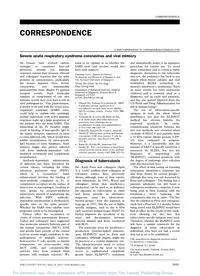
2003 Severe acute respiratory syndrome coronavirus and viral mimicry PDF
Preview 2003 Severe acute respiratory syndrome coronavirus and viral mimicry
For personal use. Only reproduce with permission from The Lancet Publishing Group. THE LANCET • Vol 361 • June 14, 2003 • www.thelancet.com 2081 CORRESPONDENCE CORRESPONDENCE COMMENTARY Severe acute respiratory syndrome coronavirus and viral mimicry Sir—Viruses have evolved various strategies to counteract host-cell processes, notably our immune responses toward their invasion. Oleszak and colleagues1 reported that the spike proteins of coronaviruses, particularly the mouse hepatitis virus, bovine coronavirus, and transmissible gastroenteritis virus, display Fc gamma receptor activity. Such molecular mimicry of components of our own immune system may even have a role in viral pathogenicity. This phenomenon, if shown to be true with the severe acute respiratory syndrome (SARS) virus, could help to explain why seemingly healthy individuals with active immune responses make up a large proportion of the patients who die from SARS. This mimicking of the Fc receptor might result in binding of non-specific IgG to the mimic receptor, expressed on virus or virus-infected cells, which would then inhibit neutralisation by virus-specific IgG because of steric hindrance. Such mimicry might also protect infected cells from antibody-dependent cell- mediated cytotoxicity and complement neutralisation. Antibody-dependent enhancement of infection has been described for certain viruses, including the feline infectious peritonitis virus (FIPV), which is a coronavirus.2 Such enhancement involves the binding of virus-antibody complexes to Fc or complement receptors on the surface of monocytes or macrophages, resulting in virus uptake via receptor-mediated endocytosis, instead of neutralising the infection. With FIPV, antibody- dependent enhancement is mediated by specific sites on the spike protein.2 Whether the SARS virus exhibits such properties needs to be investigated. Viruses affect the occurrence or course of certain autoimmune diseases. Talbot and colleagues3 have suggested that molecular mimicry between part of the human coronavirus (HCV) 229E and myelin basic protein of the central nervous system might contribute to the pathogenesis of multiple sclerosis. Autoreactive T cells specific to myelin components are cross-reactive with HCV 229E, and coronavirus-like particles have been isolated from patients with multiple sclerosis.4 We need to be vigilant as to whether the SARS virus (and vaccine) would also have such mimicry. Funding source: Agency for Science Technology and Research of Singapore, and The National University of Singapore. *Fook Tim Chew, Su Yin Ong, Choy Leong Hew Department of Biological Sciences, National University of Singapore, Science Drive 4, Singapore 117543 (e-mail:
